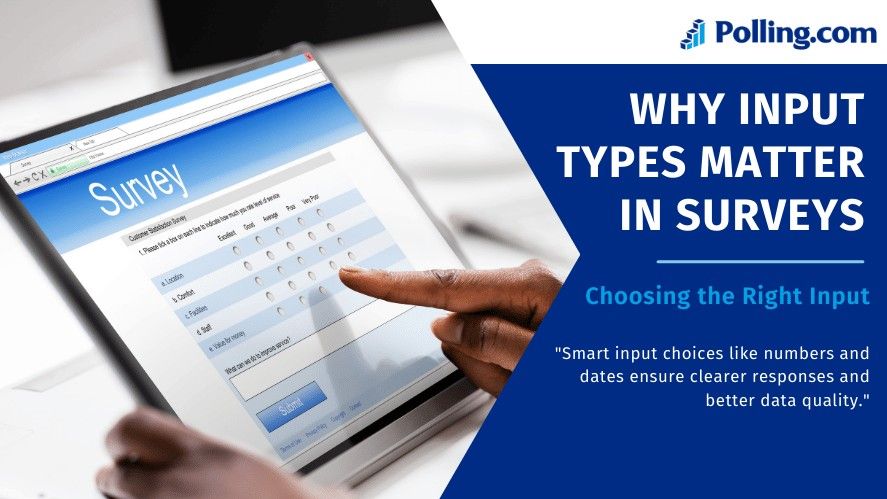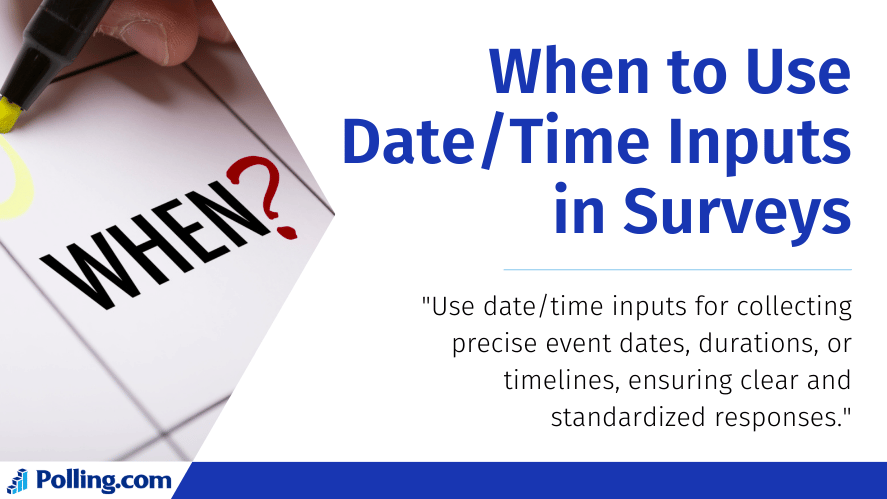
When to Use Numeric and Date/Time Inputs in Your Surveys
Creating effective surveys means ensuring they are easy to complete and deliver accurate results. Choosing the right input type plays a big role in this process. Numeric and date/time inputs, for example, help collect specific data like ages, dates, and times. This article explains how to use these inputs effectively and why they are so important.
Why Input Types Matter in Surveys

Surveys collect data that help businesses and organizations make decisions. The type of input you use like text, numbers, or dates affects the accuracy of your results and how easy it is for people to respond. Numeric and date/time inputs stand out because they simplify data collection and improve the user experience.
What Are Numeric and Date/Time Inputs?
Numeric Inputs: What They Are and Why They Matter
Numeric inputs are fields that accept only numbers. These fields are commonly used to collect:
- Ages: For demographic data.
- Ratings: Such as satisfaction scores on a scale of 1 to 10.
- Quantities: Like the number of products bought.
- Monetary values: For prices or budgets.
Benefits of Numeric Inputs
- Prevents Mistakes: Restricting input to numbers reduces errors caused by free-text responses.
- Easy Analysis: Numeric data can be directly analyzed to find averages, trends, or totals.
- Faster Responses: Respondents spend less time answering when they can quickly type numbers.
Date/Time Inputs: The Basics
Date and time inputs allow respondents to pick dates, times, or both. These are useful for collecting data like:
- Scheduling preferences: Such as availability for meetings.
- Historical data: For example, when someone made a purchase.
- Planning events: Collecting dates for RSVPs or tracking deadlines.
Why Date/Time Inputs Are Useful
- Consistency: Standardized formats avoid confusion (e.g., “MM/DD/YYYY”).
- Improves Precision: Helps gather specific details like time zones or deadlines.
- Simplifies Analysis: Makes it easier to sort and filter responses by date or time.
Benefits of Numeric Inputs in Surveys

Ensuring Accuracy in Data Collection
Numeric inputs ensure responses are consistent and free from mistakes. For example, using a numeric input for age prevents someone from typing “twenty-five” instead of “25.” This makes data analysis smoother.
Simplifying Data Analysis
Numbers are easy to analyze. You can calculate averages, totals, or trends without converting text. For instance, customer satisfaction surveys often use a numeric scale to assess performance. With numeric inputs, you can quickly identify if your average rating is improving.
Enhancing User Experience
People like fast, simple surveys. Numeric inputs are quicker to fill out, especially on mobile devices. You can even optimize them by showing a numeric keypad for easy use on phones.
Why Use Date/Time Inputs?
Collecting Precise Information
When you need exact dates or times, date/time inputs are the way to go. For example:
- An event organizer can ask, “When are you available to attend?”
- A customer feedback form might ask for a purchase date to better understand their experience.
Organizing Data Effectively
Date/time inputs make it easy to group responses by day, month, or year. This is especially helpful in long-term studies, where tracking changes over time is important.
Reducing Errors
Manually typing dates is prone to mistakes, like entering the wrong year. Using a date picker ensures all respondents use the same format, improving consistency.
When to Use Numeric Inputs in Surveys
Numeric inputs are ideal when:
- You need measurable data, like age, ratings, or income levels.
- Consistency is key, such as satisfaction ratings on a 1–10 scale.
- You’re conducting surveys that require precise calculations, like Net Promoter Score (NPS) surveys.
Tips for Using Numeric Inputs
- Set Limits: Define a range (e.g., “Enter a number between 1 and 100”).
- Provide Examples: Help users understand what to enter (e.g., “Enter your age in years”).
- Use Input Masks: For fields like money, add symbols automatically (e.g., “$”).
When to Use Date/Time Inputs in Surveys

Date/time inputs are best when:
- Collecting availability for meetings or events.
- Asking for historical information, like a product’s purchase date.
- Recording recurring data, such as weekly schedules.
Tips for Using Date/Time Inputs
- Add Date Pickers: These tools make it easy for users to select a date on both desktop and mobile devices.
- Specify Formats: Clearly indicate how dates should be entered (e.g., “YYYY-MM-DD”).
- Be Flexible with Time Zones: Let users specify their time zone or clarify which zone applies.
Avoid These Common Mistakes
Numeric Inputs: Common Pitfalls
- Overly Strict Rules: Don’t set limits that exclude valid responses. For example, avoid requiring “age under 50” if you serve a broader audience.
- Lack of Guidance: Without instructions, people might misinterpret what to enter.
Date/Time Inputs: Common Pitfalls
- Unclear Formats: If respondents don’t know how to format their answers, your data will be messy.
- Ignoring Time Zones: If exact times matter, account for respondents in different regions.
Final Thoughts
Using the right input type for your survey is essential for collecting high-quality data. Numeric inputs are perfect for measurable values like ratings and amounts, while date/time inputs shine when collecting scheduling or historical information. By following best practices and avoiding common mistakes, you can create surveys that are easy to complete and provide accurate results.
Take the time to consider your survey’s goals and audience. Thoughtful input design can make all the difference in turning raw responses into valuable insights.
